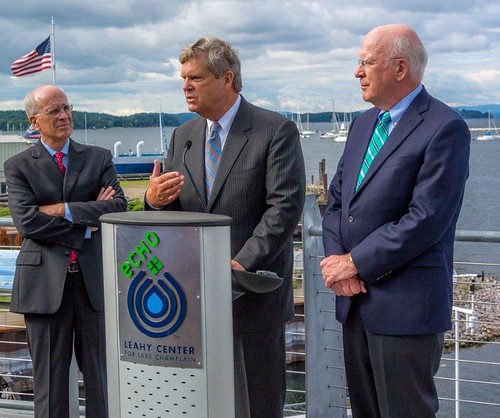
Agriculture Secretary Tom Vilsack announced that USDA will commit $45 million for on-the-ground conservation activities to protect and improve soil and water quality in the Lake Champlain Basin in Vermont over the next five years. Senator Patrick Leahy (right) and Rep. Peter Welch look on.
Lake Champlain has been plagued by blue-green algae blooms caused by a large amount of phosphorous and other nutrients in the New England lake. Recently, USDA launched a special initiative in the Lake Champlain basin, which is composed of New York and Vermont, to invest $45 million in protecting and improving soil and water quality over the next five years.
“Our work helps farmers prevent phosphorus laden runoff which leads to the blue green algae blooms,” said Vicky Drew, the state conservationist for USDA’s Natural Resources Conservation Service in Vermont. “NRCS conservationists work with farmers to ensure that manure is properly stored, and we provide assistance in the application of manure to their fields according to a nutrient management plan.”
Funding for this program comes from the Environmental Quality Incentives Program, one of the conservation programs offered by the 2014 Farm Bill. This program will help Vermont farmers put into place conservation practices that help farmers keep water clean and soil in place, such as cover cropping, tillage systems, vegetative buffers and others.
The funding is targeted to areas where blue-green algae blooms are frequent, including Missisquoi Bay, St. Albans Bay and the South Lake — areas of Lake Champlain where blue-green algae blooms are frequent.
Phosphorus can affect water quality by enabling excessive aquatic plant and algae growth, which contributes to fish die offs and other environmental impacts. The algae blooms are the result of degraded water quality caused partially by runoff of phosphorous.
Agriculture is one contributor of phosphorous, but municipalities and industries also contribute to the problem.
Agriculture Secretary Tom Vilsack recently visited Vermont to announce this funding and meet with local farmers and leaders.
“This is the sixth largest freshwater body in the country. And there’s no question it needs help,” Vilsack said “We are dedicated to protecting and improving this beautiful and unique natural resource.”
Added Rep. Peter Welch at the announcement: “The future of our lake will depend on effective conservation measures, which these funds will support.”
Lake Champlain was formed about 200 million years ago when the continents stretched, causing massive bedrock to fall between two faults. This incredible natural resource contains 435 square miles of surface water and is 120 miles long, and is nestled between the Green Mountains of Vermont and the Adirondack Mountains of New York. At its widest point, the lake spans 12 miles with an average depth of 64 feet, and it is adorned with 600 miles of shoreline and over 70 islands.
The lake holds 6.8 trillion gallons of water and provides drinking water for over 200,000 people, habitat for over 300 bird species, and brims with 81 fish species.
This September, USDA is celebrating the many opportunities and benefits provided by conservation by highlighting stories like this one. To get started with NRCS, visit your local USDA Service Center or www.nrcs.usda.gov/GetStarted.
No comments:
Post a Comment
Note: Only a member of this blog may post a comment.